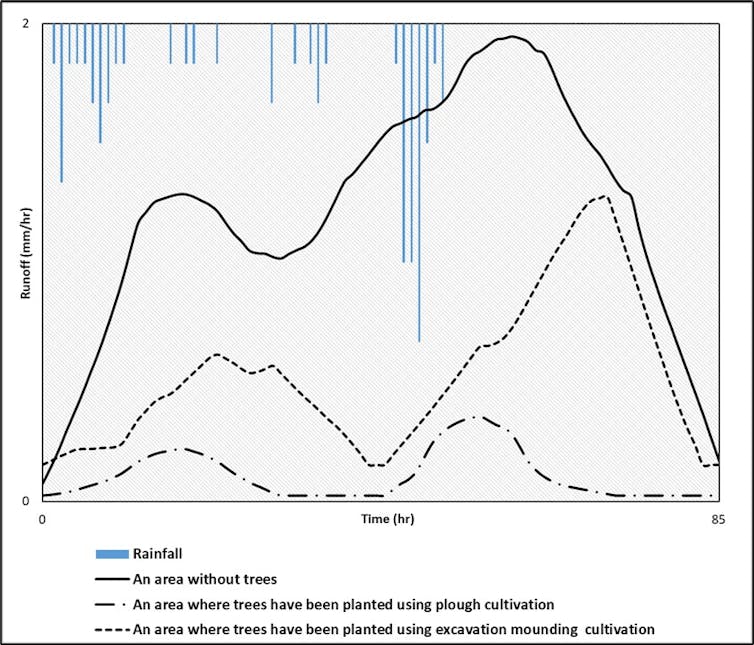Think of flood prevention and you might imagine huge concrete dams, levees or the shiny Thames barrier. But some of the most powerful tools for reducing flood risk are far more natural and widely recognisable: woodlands and green spaces. Trees offer much more than beauty and oxygen. Here’s how trees help to protect us from floods.
1. Intercepting rainfall
Trees and green spaces hold the key to protecting us against flooding. When rain falls on a forest, trees play a vital role in managing water flow. The canopy of a forest acts like a giant umbrella, catching and holding rainwater before it hits the ground.
This slows down how quickly rain reaches the soil, allowing water to gradually seep into the earth instead of rushing over the ground and straight into rivers and watercourses. This delayed water flow can reduce peak water levels in rivers during heavy storms, helping to prevent flash floods.
One of us (Martina) was involved in a two-year study, which has not been peer reviewed, that used sensor equipment to measure the speed and level of surface water at various locations along two streams in the Menstrie catchment area in Scotland: one with greater tree cover and another with less.
The stream with more trees appeared to have consistently reduced flow discharges compared with the more barren stream. This suggests that young forests may be able to dramatically reduce water runoff during rainfall, potentially preventing water from overwhelming streams and rivers.
As trees grow and mature, their effect on water management could become even more significant. This study adds to a growing body of evidence that shows forests offer a natural defence against floods.
Trees are one of our best allies in adapting to the increasing risks posed by climate change. Trees also remove water from catchments via evapotranspiration, whereby moisture evaporates from the surface of the soil and is released from the plant’s leaves and other surfaces.
Importantly, these processes aren’t just relevant at the scale of rural, catchments. We can use the benefits of trees and plants in our towns and cities as targeted small-scale interventions.
2. Keeping rivers clean
Trees help keep rivers clean and healthy. When there are no trees, rain can wash away a lot of soil (and pollutants) into rivers. This might lead to them having a reduced capacity to convey water. But tree roots act like anchors, binding the soil in place and preventing it from flowing into rivers.
This keeps the rivers clear and stops sedimentation, helping them cope with flood waters better. That, in turn, can prevent flooding and maintain river capacity to protect against future flooding.
In places like the Menstrie catchment, planting trees around rivers helps trap dirt and sediment in the upper parts of the river, keeping the lower parts cleaner.
Ploughed ground can better capture sediment across the catchment because the plough lines act as barriers. They keep the sediment in place more efficiently than other techniques, such as hand-screefing (when someone clears a small spot of ground by hand to plant a tree) and excavator mounding (a process that uses a machine to build little hills to help trees grow better in wet areas), which were less successful in containing the sediment.
Evidence shows that trees are essential for long-term soil stabilisation. Cultivation methods and forestry practices therefore play a crucial role in managing erosion and sediment flow.
3. Absorbing and storing water like sponges
Trees improve the soil’s ability to soak up water. Their roots channel deep into the ground, creating preferential flow paths that allow water to absorb into the soil profile, rather than run off on the surface. This process helps reduce the amount of water rushing towards rivers and streams after a heavy rainstorm, which is a major factor in slowing the flow of water and reducing flooding.
How trees are planted, the slope of the land and the type of soil all affect how much water runs off during rainfall. Different planting techniques affect water runoff differently depending on the amount of rain.
During floods, some areas with trees planted (that includes plots with plough cultivation and excavation mounding) have less water runoff compared with unplanted areas without trees.
4. Reducing surface runoff
When heavy rain falls on bare land, water runs off quickly, which can cause floods. Trees, with their roots and fallen leaves, slow this down by helping the ground soak up more water.
This reduces how much water flows into rivers all at once, helping to prevent floods. Planting trees using different layouts, densities and patterns can make this even more effective by helping trees grow better and absorb more water, thereby reducing runoff.

5. Stopping floodwaters
In Somerset, England tree planting projects along rivers, such as those under the Environment Agency’s initiative, have played a crucial role in reducing flood risks.
Since 2020, almost 30,000 trees and shrubs were planted across multiple sites to help slow water flow and protect communities vulnerable to flooding. These trees were strategically placed along riverbanks, including in the Parrett catchment in Somerset, an area known to be prone to flooding.
Underground, tree roots drink up lots of water, slowing how quickly the rainwater flows. And when floodwater hits a forest, the tree trunks act like a natural barrier or wall, slowing the water down so it doesn’t rush all at once to other areas and cause bigger floods. By planning and planting forests to build climate resilience, these positive effects can become even stronger.

Don’t have time to read about climate change as much as you’d like?
Get our award-winning weekly roundup in your inbox instead. Every Wednesday, The Conversation’s environment editor writes Imagine, a short email that goes a little deeper into just one climate issue. Join the 35,000+ readers who’ve subscribed so far.

The post “Five surprising ways that trees help prevent flooding” by Martina Egedusevic, PhD Candidate, Impact Fellow (Green Futures Solutions), University of Exeter was published on 10/17/2024 by theconversation.com




































Leave a Reply